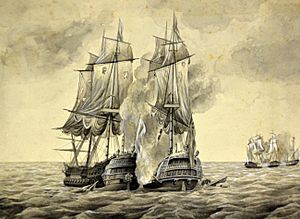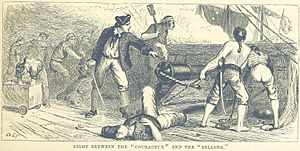Battle of Cape Finisterre (1761) facts for kids
Quick facts for kids Battle of Cape Finisterre |
|||||||
|---|---|---|---|---|---|---|---|
| Part of the Seven Years' War | |||||||
 Bellona and Courageux, Henry Fletcher |
|||||||
|
|||||||
| Belligerents | |||||||
| Commanders and leaders | |||||||
| Strength | |||||||
| 1 ship of the line 1 frigate |
1 ship of the line 2 frigates |
||||||
| Casualties and losses | |||||||
| 11 killed 44 wounded |
240 killed 110 wounded 1 ship of the line captured |
||||||
The Battle of Cape Finisterre was an important sea battle. It happened off the coast of Spain near Cape Finisterre. This fight was between British and French ships during the Seven Years' War.
On August 13, 1761, two British ships were sailing. These were HMS Bellona (a large 74-gun ship) and HMS Brilliant (a smaller 36-gun frigate). They were carrying valuable cargo from Lisbon to Britain. Suddenly, they spotted three French ships. The French force included the 74-gun Courageux and two 32-gun frigates, Malicieuse and Hermine.
The British ships immediately began to chase the French. They kept sight of them all night. The next morning, two separate battles began. Brilliant fought the two French frigates. At the same time, Bellona bravely battled the large French ship Courageux.
In a quick but fierce fight, both big ships were damaged. The battle turned when Captain Robert Faulknor of Bellona moved his ship skillfully. He got into a perfect position to fire directly along the side of Courageux. This caused huge damage and many casualties to the French ship. Courageux was forced to surrender. Even though it was outnumbered, Brilliant successfully kept the French frigates busy. This stopped them from helping Courageux. After Courageux surrendered, Malicieuse and Hermine sailed away. Later, Courageux was repaired and joined the British Royal Navy. It served for 35 more years in other wars.
Why This Battle Happened
After a big defeat in 1759 at the Battle of Quiberon Bay, the French Navy was weaker. They could no longer control the seas around Europe. The Royal Navy (British Navy) took advantage of this. In April 1761, they even captured Belle Île, an island off France.
Since the main French fleet was stuck in port, smaller French groups went out. They tried to raid British ships and areas. One such group was led by Captain Dugué L'Ambert. His group included the 74-gun Courageux and the frigates Malicieuse and Hermine. They had been on a successful raiding trip in the West Indies. In early August, they were returning to Europe.
Late on August 13, 1761, L'Ambert's ships were sailing near Cape Finisterre. They saw sails close to the shore. These were the British ships, HMS Bellona and HMS Brilliant. The British ships were carrying over £100,000 in valuable coins. The French first thought both British ships were large warships. They tried to escape in the dark. But the bright moonlight helped the British keep chasing them.
The Battle Begins
At 5:00 AM on August 14, Captain L'Ambert changed his mind. He thought Bellona was a smaller 50-gun ship. Feeling confident, he turned his ships around to face the British. He ordered Malicieuse and Hermine to attack Brilliant. He would lead Courageux against Bellona.
The two large ships, Courageux and Bellona, sailed towards each other. At 6:25 AM, L'Ambert brought Courageux alongside Bellona. He immediately opened fire with his broadside (all the guns on one side). Captain Faulknor of Bellona waited. He fired his own guns after the second French broadside. His crew fired two quick broadsides. Faulknor also reversed his sails, swinging Bellona right next to Courageux.

The French guns were very effective at first. Nine minutes after the firing started, Bellona's mizzen-mast (the mast at the back) crashed down. A crewman was worried about the damage. Captain Faulknor reportedly told him, "Confound you! you rascal, what has a two-decked ship to do with a mizzen-mast in the time of action. See and knock away his mizzen-mast."
Faulknor worried that Courageux might try to escape. He wanted to board the French ship. But the French ship moved away. Its own mizzen-mast fell down at 6:45 AM. Even with damaged sails, Faulknor managed to turn Bellona. He brought his ship across the back of Courageux. He then fired many raking broadsides. These shots caused terrible damage to Courageux's hull. Hundreds of French sailors were killed or wounded. The French captain, L'Ambert, was badly wounded. He decided to strike his colours (surrender) at 7:04 AM. Some lower deck guns on the French ship kept firing. Faulknor ordered two more broadsides into Courageux to make sure they stopped.
Frigates and Aftermath
While the two big ships fought, Brilliant was busy. From 6:00 AM to 7:30 AM, it fought off the two French frigates. Malicieuse attacked first, then Hermine. Brilliant bravely kept them from joining the main battle. When it was clear Courageux had surrendered, the French frigates sailed away. Brilliant stayed with Bellona and the captured ship.
The British lost 6 killed and 28 wounded on Bellona. On Brilliant, 5 were killed and 16 wounded. The losses on Courageux were much higher. Captain Faulknor reported 240 killed and 110 wounded. This big difference might be because of different fighting styles. The French often aimed at masts and rigging to disable ships. The British aimed at the hull to kill the crew.
The captured Courageux was taken to Lisbon. Crowds cheered its arrival. One historian later said Bellona's actions were like a skilled gladiator. The ship not only landed its own blows but also defended itself well.
After repairs, Courageux joined the Royal Navy as HMS Courageux. It served for 35 years. It fought in the American Revolutionary War and the French Revolutionary Wars. Sadly, it was wrecked in a storm in 1796. Over 470 lives were lost.

